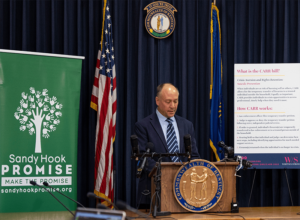Through the Say Something program, Sandy Hook Promise has taught countless students how to recognize the warning signs of someone at risk of hurting themselves or others. Then, students learn how to speak up to a Trusted Adult to get help.
But what happens when someone raises their concerns of potential school violence, and no one takes it seriously?
In January 2023, a teacher was shot in her classroom by a six-year-old student at Richneck Elementary School in Newport News, Virginia. This could have been prevented if a gun had been securely stored by an adult. As the story began to unfold, the public learned that adults had ignored multiple reported warning signs. Reporting these signs could have led to averting the shooting and avoiding trauma.
In this unthinkable story, some adults failed this school community — but it doesn’t have to be that way. Everyone has a responsibility in maintaining a safe school community.
Here’s how you can help.
Train and Value Trusted Adults
People embrace being Trusted Adults when they are empowered with the proper tools and resources to teach their students to be Upstanders. Trusted Adults are the grownups working in schools and community settings who are consistent and dependable sources of support for students. We teach students — the eyes and ears of the school — how to recognize the signs of violence. Then, students learn to come forward to adults whom they know have their backs. It’s this relationship and connection with adult allies that is critical to averting tragedy.
Being a Trusted Adult is a companion, no-cost training to the Say Something program for students. Participants have access to training videos, worksheets, and activities with tips and resources to help adults understand how to better support youth in their community. Trusted Adults can be teachers, admins, librarians, cafeteria staff, custodial staff, anyone who interacts with students often.
Know Your School Safety Plan
Whether you’re an educator, administrator, parent, or concerned community member, it’s important to know how your school receives and reacts to concerns of potential violence. While your school may not be able to tell you the outcome or details of a report, they should be able to explain its threat management process.
How Do You Write a School Safety Plan?
If your school doesn’t have a procedure or safety plan in place, encourage them to implement one. The purpose of a school safety plan is to prepare for and prevent security risks in your school. These commonly include plans to address the physical and behavioral aspects of keeping your students safe. Sandy Hook Promise focuses on intervention and prevention strategies for your safety plan. Our Guiding Principles of Threat Assessment outlines these strategies. School safety experts, as well as students, educators, and survivors of gun violence, developed the guide.
Share our guide with stakeholders to start the conversation with your school. It is filled with useful examples and can be used to write your plan and create school safety plan checklists.
Advocate for School Preparedness Plans
A Trusted Adult consistently communicates the need for safety plans with school stakeholders. They begin and lead conversations with a plan. Some communication tips to keep in mind are:
- Set your expectations: If you aren’t entirely happy with your school’s plan, find a school or district like yours with a plan and break it down. What do you like about it? What is realistic for your school?
- Have concrete suggestions: You can convey exactly what you’d like to see happen and they can tell you if it’s feasible or not.
- Prepare to discuss the impact a program has made in a community. Research programs like Say Something or Start With Hello that you would like to propose.
Learn What it Will Take to Get to “Yes”
There’s truth in the “squeaky wheel always getting the oil.” This holds true for school safety and gun violence prevention and preparedness planning too. In short, following up and perseverance are key. Ask constructive school safety plan questions, such as:
- What’s your school or district’s procedures or forms for reporting an incident or warning signs? How are they accessible for the community?
- Do you need additional information or corroboration for your report?
- Is there another local entity (e.g., police, school district, specific administrators) that also needs to receive the report?
- How can you provide as much information as possible to your school or district?
School Safety Prevention and Prevention Work Together
In general, preparedness plans are for when a crisis is already unfolding. Prevention reduces the likelihood that a crisis will occur. Advocating for programs like Know the Signs will encourage your school to bring in universal prevention programs.
Combatting school violence takes a collaborative, holistic approach. Find out how your school can help create a culture of Upstanders, and a safer, more connected school community.


